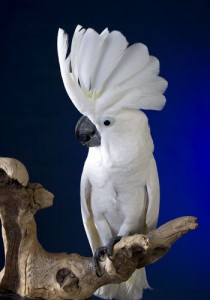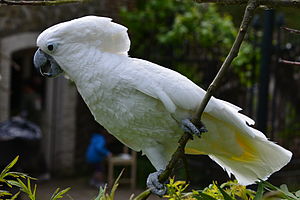 The white
cockatoo (Cacatua alba), also known as the umbrella cockatoo,
is a medium-sized all-white cockatoo endemic to tropical rainforest
on islands of Indonesia. When surprised, it extends a large and striking
head crest, which has a semicircular shape (similar to an umbrella, hence
the alternative name). The undersides of the wings and tail have a pale yellow
or lemon color which flashes when they fly. It is similar to other species of
white cockatoo such as yellow-crested
cockatoo, sulphur-crested cockatoo, and salmon-crested cockatoo, all
of which have yellow, orange or pink crest feathers instead of white.
The white
cockatoo (Cacatua alba), also known as the umbrella cockatoo,
is a medium-sized all-white cockatoo endemic to tropical rainforest
on islands of Indonesia. When surprised, it extends a large and striking
head crest, which has a semicircular shape (similar to an umbrella, hence
the alternative name). The undersides of the wings and tail have a pale yellow
or lemon color which flashes when they fly. It is similar to other species of
white cockatoo such as yellow-crested
cockatoo, sulphur-crested cockatoo, and salmon-crested cockatoo, all
of which have yellow, orange or pink crest feathers instead of white.
It kingdom
is Animalia, phylum is Chordata, class is Aves, order is Psittaciformes,
superfamily is cacatuoidea, family is Cacatuidae, subfamily is Cacatuinae,
tribe is Cacatuini, genus is Cacatua, subgenus is Cacatua, species is C.alba.
 The white cockatoo is around 46 cm (18 in) long, and weighs about 400 g (14 oz) for small females and up to 800 g (28 oz) for big males. The male white cockatoo usually has a broader head and a bigger beak than the female. They have brown or black eyes and a dark grey beak. When mature some female white cockatoos can have reddish/brown irises, while the irises of the adult male are dark brown or black.
The white cockatoo is around 46 cm (18 in) long, and weighs about 400 g (14 oz) for small females and up to 800 g (28 oz) for big males. The male white cockatoo usually has a broader head and a bigger beak than the female. They have brown or black eyes and a dark grey beak. When mature some female white cockatoos can have reddish/brown irises, while the irises of the adult male are dark brown or black.
The feathers of the white cockatoo are mostly white. However, both upper and lower surfaces of the inner half of the trailing edge of the large wing feathers are a yellow color. The yellow color on the underside of the wings is most notable because the yellow portion of the upper surface of the feather is covered by the white of the feather immediately medial (nearer to the body) and above.
 Cacatua
alba is
endemic to lowland tropical rainforest on the islands of Halmahera, Bacan, Ternate, Tidore, Kasiruta and Mandioli (Bacan group)
in North Maluku, Indonesia. It occurs in primary, logged, and secondary
forests below 900m. It also occurs in mangroves, plantations including coconut
and agricultural land. In the wild, white cockatoos
feed on berries, seeds, nuts, fruit and roots. When nesting, they include
insects and insect larvae. In their natural habitat, umbrella cockatoos
typically feed on various seeds, nuts and fruits, such as papaya, langsat, and
rambutan.
Cacatua
alba is
endemic to lowland tropical rainforest on the islands of Halmahera, Bacan, Ternate, Tidore, Kasiruta and Mandioli (Bacan group)
in North Maluku, Indonesia. It occurs in primary, logged, and secondary
forests below 900m. It also occurs in mangroves, plantations including coconut
and agricultural land. In the wild, white cockatoos
feed on berries, seeds, nuts, fruit and roots. When nesting, they include
insects and insect larvae. In their natural habitat, umbrella cockatoos
typically feed on various seeds, nuts and fruits, such as papaya, langsat, and
rambutan.
Like all
cockatoos, the white cockatoo nests in hollows of large trees. Its eggs are
white and there are usually two in a clutch. During the incubation period –
about 28 days – both the female and male incubate the eggs. The larger chick
becomes dominant over the smaller chick and takes more of the food. The chicks
leave the nest about 84 days after hatching and are independent in 15–18
weeks. Juveniles reach sexual maturity in 3–4 years.
Question:
1. Why the white cockatoo is also known as umbrella cockatoo? Because white cockatoo...
A. is a medium-sized all-white cockatoo.
B. has yellow, orange, or pink crest feathers.
C. extends a large and striking head crest.
D. head crest has semicircular shape.
E. endemic to tropical rainforest on islands of Indonesia.
2. Which one is the correct statement according to the text?
A. White cockatoo order is cacatuoidae.
B. White cockatoo nests in hollows small tree.
C. When mature some male white cockatoos can have reddish/brown irises.
D. The feathers of white cockatoo is all white.
E. The male white cockatoo usually has a broader head and a bigger beak than the female.
3. What is the female white cockatoo usually has? Compared to the male
A. A broader head and a bigger beak.
B. A yellow, orange, or pink crest feathers.
C. A narrower head and a smaller beak.
D. A brighter yellow colour for the undersides of the wings.
E. Yellow irises.
4. What is the usual weight for white cockatoo?
A. Below 400g
B. Only 400g
C. Below 800g
D. Between 400-800g
E. More than 800g
5. Which one is the correct statement according to the text?
A. Cacatua alba is not endemic to lowland tropical rainforest in North Maluku, Indonesia.
B. The larger white cockatoo chick becomes dominant over the smaller chick and takes more of the food.
A. In their natural habitat, umbrella cockatoos typically feed on various vegetables.
D. It always occurs in mangroves, plantations including coconut and agricultural land.
E. During the incubation period – about 28 days – neither the female nor male incubate the eggs.
Source:
https://en.wikipedia.org/wiki/White_cockatoo
https://lafeber.com/pet-birds/species/umbrella-cockatoo/
http://www.mongabay.co.id/2015/05/22/kakatua-paruh-bengkok-sejuta-pesona-yang-merana/
Tidak ada komentar:
Posting Komentar